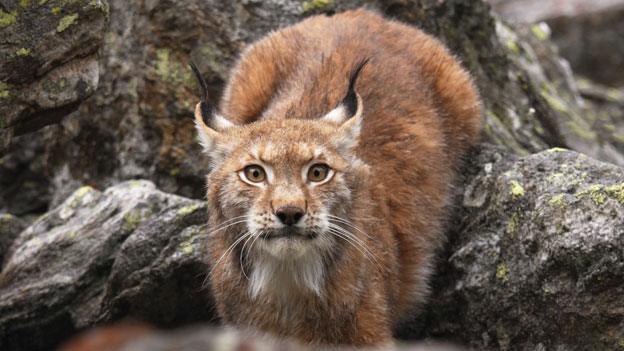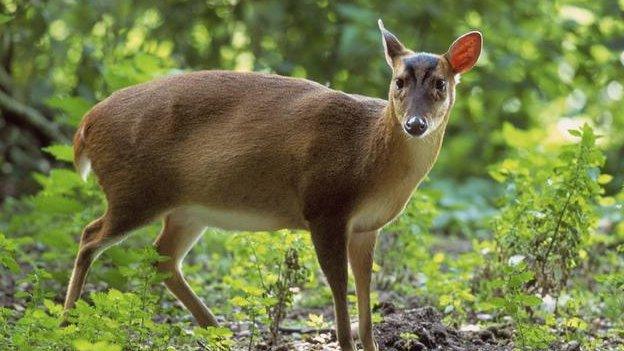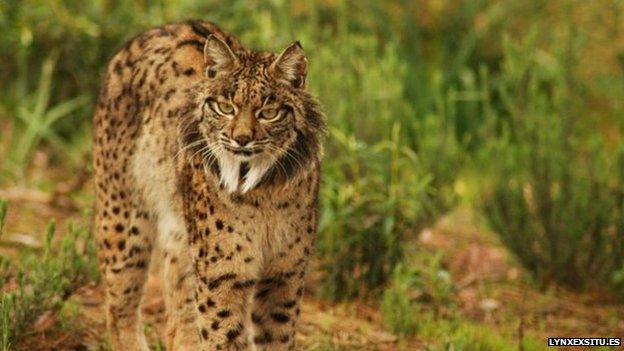Should the lynx be reintroduced to Britain?
- Published

Eurasian lynx is solitary and elusive
As each successive 'sighting' of a big cat in the British countryside disappears into a media-stoked mirage, it is time to ask whether we should release real 10-30 kg cats onto our land once more.
The Lynx UK Trust wants to do just this.
It has launched a questionnaire to find out what people think, before it then asks the Natural England and Scottish Natural Heritage for permission to go ahead with trial releases.
Polarised views are likely to be expressed. Some would love to see cute tufty-eared and spotty cats wandering our woods and hills and controlling plagues of deer that are destroying our woodlands.
Others fear that these 'fierce' carnivores would eat our sheep, threaten the livelihoods of farmers and gamekeepers, endanger native British species, and leave pet owners and even parents in fear.
But it is not clear what information is being provided to help people make a dispassionate judgement.
What are the possible advantages and disadvantages?

Eurasian lynx
Medium-sized cat found in western Europe, Russia and central Asia. The last British lynx, closely related to the north European lynx, disappeared around 700 AD.
It hunts deer and smaller species such as rabbit and hare and is highly elusive.
Other European countries which have successfully reintroduced lynx have developed wildlife tourism alongside them.
The animals are solitary apart from during the breeding season.
Adults vary in size from 80-130cm in length and up to 70cm at the shoulder. They can weigh from 10-40kg.
Source: Lynx UK Trust

Pros
The Eurasian lynx was the largest wild species of cat in Britain throughout the last 10,000 plus years, only dying out in the first millennium AD, almost certainly as a consequence of human persecution.

Muntjac deer is among the lynx's prey
It 'belongs' in our countryside. Indeed, we are obliged under the European Habitats Directive to "study the desirability of reintroducing [threatened] species" that have become extinct from our region.
The suggested benefits of reintroducing lynx are to make British ecosystems more natural, attract ecotourism, control deer populations and hence reduce economic damage to forestry, and thus allow forests to regenerate naturally.
This would reduce the need for costly deer fences, increase the amount of undergrowth in woodlands (benefitting some woodland birds), and reduce the numbers of deer spilling out of the woods and eating farmers' crops.
The lynx are also likely to eat 'invasive' muntjac deer and rabbits, neither of which are native to Britain, and they will sometimes kill foxes.
There is a negligible direct risk to humans.
Seems sensible.
Cons
Not all benefits will necessarily be realised, and there are some genuine risks.
The numbers of deer killed by lynx in European studies seem insufficient to reduce deer populations to the point that they would allow tree generation.

Endangered capercaillies could be a target
Benefits in Scotland may be minimal because the main culprit preventing regeneration is red deer, whereas the lynx usually catch the smaller roe deer.
Most European studies find low predation rates on domestic livestock (a farmer compensation system will be needed) in areas where sheep are rare, but a recent study in Norway reported lynx to be killing twice as many domestic sheep as roe deer in summer.
We need to take care in the sheep-strewn British countryside.
They also sometimes eat grouse and presumably pheasants, which will bring them into conflict with landowners even if the actual losses are fairly small.
The Royal Society for the Protection of Birds will also be unhappy if lynx eat the last 1,300 surviving capercaillies, the largest species of grouse in Scotland.
An alternative?
Then there is the cost.
The Eurasian lynx is one of the least threatened species of cat in the world and it is already increasing in continental Europe.

Conservation efforts have successfully raised the Iberian lynx population to more than 300, but many have been killed on Spanish roads
Why spend hundreds of thousands if not millions of pounds on a species that is not endangered when we could introduce the much smaller Iberian lynx, which is the most threatened species of cat on Earth?
The Iberian species is now restricted to Spain and Portugal, but its ancestors lived throughout Europe before they were displaced by the incoming Eurasian species, which arrived from the east some 130,000 years ago.
The Iberian lynx appears to be the closest surviving relative of the original British lynx - why not introduce this truly-endangered rabbit-eating cat instead?
- Published9 March 2015
